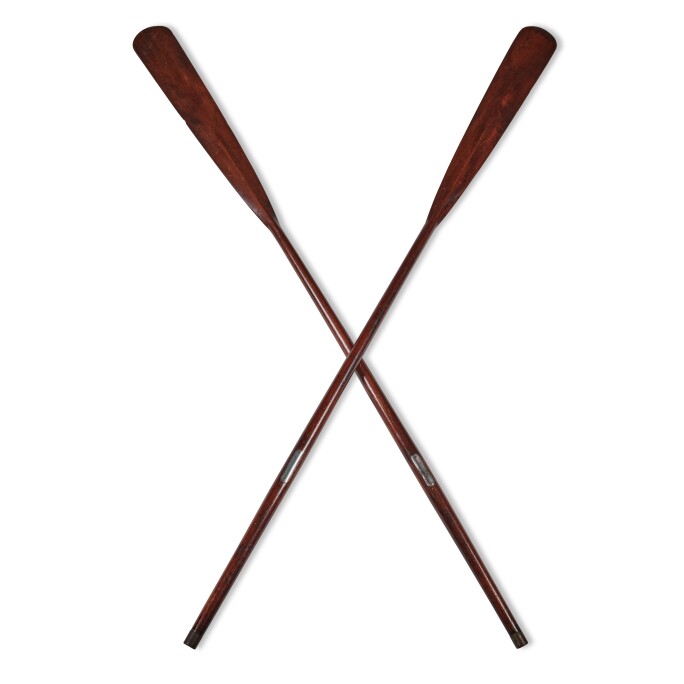F ew rivalries in sports are as storied and have such a long history of passionate competition as Harvard-Yale, two titans of the Ivy League. This May, Sotheby’s will auction the object central to the foundation of this rivalry and an important piece of American culture and sports history: the Harvard-Yale Regatta 1852 Trophy Oars. Marking the birth of intercollegiate sport in America and the oldest continual collegiate athletic competition, the oars were presented to the winning Harvard crew by General Franklin Pierce — the future President of the United States — to commemorate the very first rowing match between Harvard and Yale in August 1852, which would become the longest running competition in American intercollegiate sporting history.
On offer with an estimate of $3/5 million and appearing at auction for the first time this May in a dedicated single lot auction, the oars were previously lost to history before they were rediscovered in the basement of a rooming house in Medford, Massachusetts, about thirty years ago. Recognizing the significance of the pair, the children of the present owner prevented the oars from heading to the rubbish pile, preserving an iconic piece of American and collegiate history. Since then, the pair has remained in the family’s private collection.

Pre-dating the first intercollegiate football game, which took place in 1869, and first intercollegiate basketball game, which took place in 1895, the 1852 Harvard–Yale regatta oars not only represent the birth of intercollegiate sports in America, but are also among the oldest pieces of sports memorabilia in American history.
In 1852, Yale oarsman James Whiton suggested a race between Harvard and Yale, and secured an agreement between the crews to test the might of the two universities' oarsmen. Whiton met James N. Elkins — superintendent of the Boston, Concord, and Montreal Railroad — who also encouraged the idea of a race. Whiton then struck a marketing deal with the railroad. Held on Lake Winnipesaukee in New Hampshire, the destination event would draw spectators to the race via the new railroad. Taking place on 3 August 1852, the inaugural contest was a large spectacle, and deemed a success for the railroad as well as rowers. After a spirited two-mile race in front of enthusiastic crowds, Harvard was the victor. Made of black walnut with engraved silver plaques, the team was awarded the present Trophy Oars by future President of the United States General Franklin Pierce, who had recently been nominated by the Democratic Party as their presidential candidate.
The next race was held in July 1855, with Harvard winning by one minute and 38 seconds. While the universities competed again in 1859 and 1860, the Regatta became an annual event in 1864. The closest known game occurred in 1914, with Yale beating Harvard by 1/5 second. Beginning in 1959, the Crimson won twenty-one of the next twenty-two races. Of these, the team won eighteen in a row — between 1962 and 1980 — which kicked off legendary crew coach Harry Parker’s tenure. During the final win in this eighteen-year run, Harvard established a time of 18:22.4 in its two-length victory — a record that still stands.
Following the inaugural race in 1852, the competition has been an annual event since 1859, with only a few exceptions, including World War Two, most notably. The race is currently held on the Thames River near New London, Connecticut, and the 155th regatta will take place 11 June, marking the first race since 2019.
“These trophy oars mark the beginning of American intercollegiate sports, and stand as a significant relic of American history. These icons of sport predate the Civil War, and their incredible chance rediscovery four decades ago saved them from being lost forever. Sotheby’s holds a longstanding track record of offering the most important sports artifacts, and we’re thrilled to once again present for sale a landmark piece of American sports history.”
The auction of the Harvard-Yale Trophy Oars continues Sotheby’s longstanding track record of offering the most important artifacts and objects in the history of sport, including the Olympic Manifesto — the foundational document outlining the birth of the modern Olympic Games — which sold for $8.8 million, making it the current world auction record for any piece of sports memorabilia; The Founding Rules of Basketball by James Naismith, which sold for $4.3 million in 2010; Michael Jordan’s Regular Season Game Worn Nike Air Ships, which sold for $1.47 million in 2021, marking a world record for the highest price achieved for a pair of sneakers at auction.
The online sale will be open for bidding 17 – 24 May, with an exhibition at Sotheby’s York Avenue galleries open to the public 19 – 23 May.



